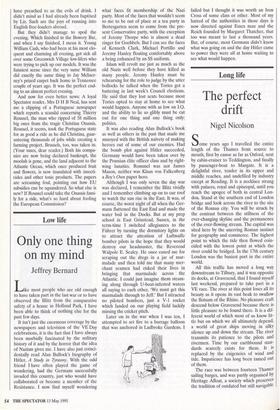Long life
The perfect drift
Nigel Nicolson
Some years ago I travelled the entire length of the Thames from source to mouth, first by canoe as far as Oxford, next by cabin-cruiser to Teddington, and finally by passenger-boat to Margate. It is a delightful river, tender in its upper and middle reaches, and undefiled by industry except at Reading. It is a necklace strung with palaces, royal and episcopal, until you reach the apogee of both in central Lon- don. Stand at the southern end of London bridge and look across the river to the site of the Roman city. You will be struck by the contrast between the stillness of the ever-changing skyline and the permanence of the ever-flowing stream. The capital was sited here by the unerring Roman instinct for geography and commerce. The highest point to which the tide then flowed coin- cided with the lowest point at which the river could be bridged. In the 17th century London was the busiest port in the entire world.
All this traffic has moved a long way downstream to Tilbury, and it was opposite its docks, at Gravesend, that I found myself last weekend, prepared to take part in a VE race. The river at this point loses all its beauty as it opens its vast beak to swallow the flotsam of the Rhine. No pleasure craft descend below Gravesend because there is little pleasure to be found there. It is a dif- ferent world of which most of us know lit- tle but on which we all ultimately depend, a world of great ships moving in silky silence up and down the stream. The river transmits its patience to the pilots and rivermen. Time by our earthbound stan- dards scarcely exists for them. It is replaced by the exigencies of wind and tide. Impatience has long been tamed out of them.
The race was between fourteen Thames sailing barges, and was partly organised by Heritage Afloat, a society which preserves the tradition of outdated but still navigable craft like the Thames barges. The barge on which I was passenger was named Ironsides. She is a sturdy, flat-bottomed boat, built in 1900 to transport stone from the Portland quarries to London, and her holds have now been converted into spacious saloons and cabins which you can hire for up to 22 guests. She has an engine, but to use it in the race was unthinkable. She raised her great brown sails on those diagonal spars that give the barges their distinctive outline familiar from 19th-century prints.
Our race took place on a beautiful day which was totally windless. The sails hung foolishly like washing. We were obliged to drift out on the ebb tide and drift back on the flood, taking twelve hours to cover the 16 miles from Gravesend to Southend and back. A 90-ton sailing barge, bereft of wind to sail by, must be the slowest form of loco- motion ever devised by man. But it does not mean that manoeuvre is impossible. Skilled skippers can read the Thames and its eddies like books, judging the pace of the tide at certain angles of the river that will give them a fractional advantage.
It was not obvious to me what they were attempting, because our progress was slow- er than a slow walk, but the result was evi- dent ten minutes later in the gap that opened between Ironsides and her nearest rival. She was not the first home to Gravesend, but she won two cups, for the best start and neatest in rounding the ter- minal buoy. Most impressive of all was the good temper of these river mariners. There was no mutual abuse when we were in dan- ger of collision, no insulting grimaces when we were losing, nor jubilation when we slowly drew ahead. Not only do these watermen and watergirls have a different sense of time. They have different rules of courtesy.



































































 Previous page
Previous page